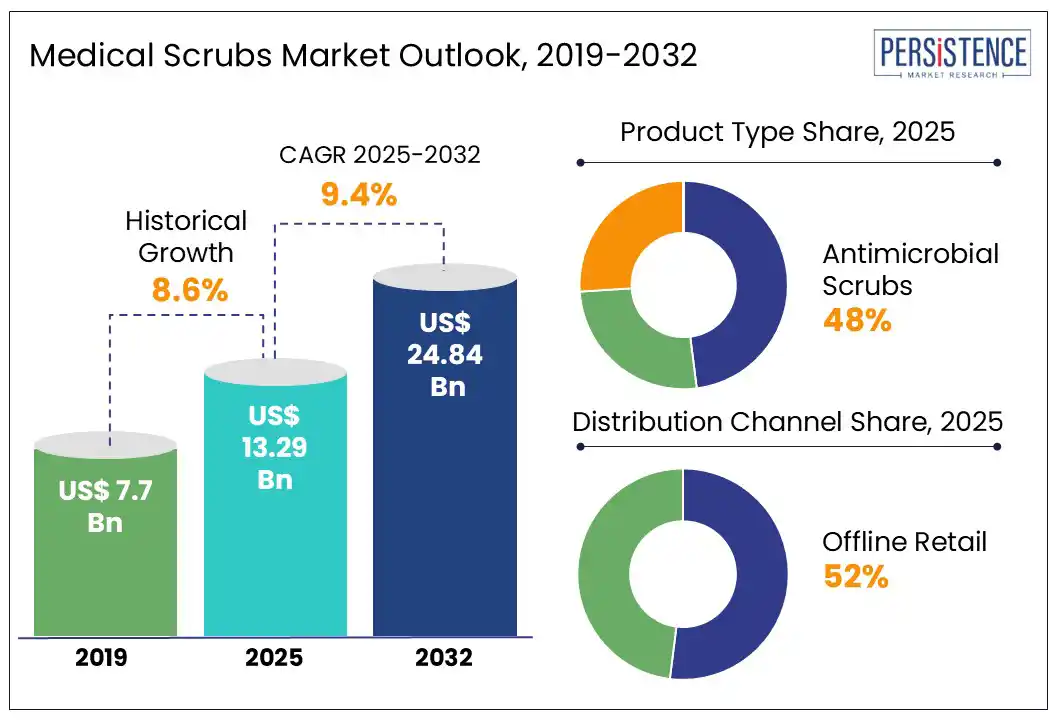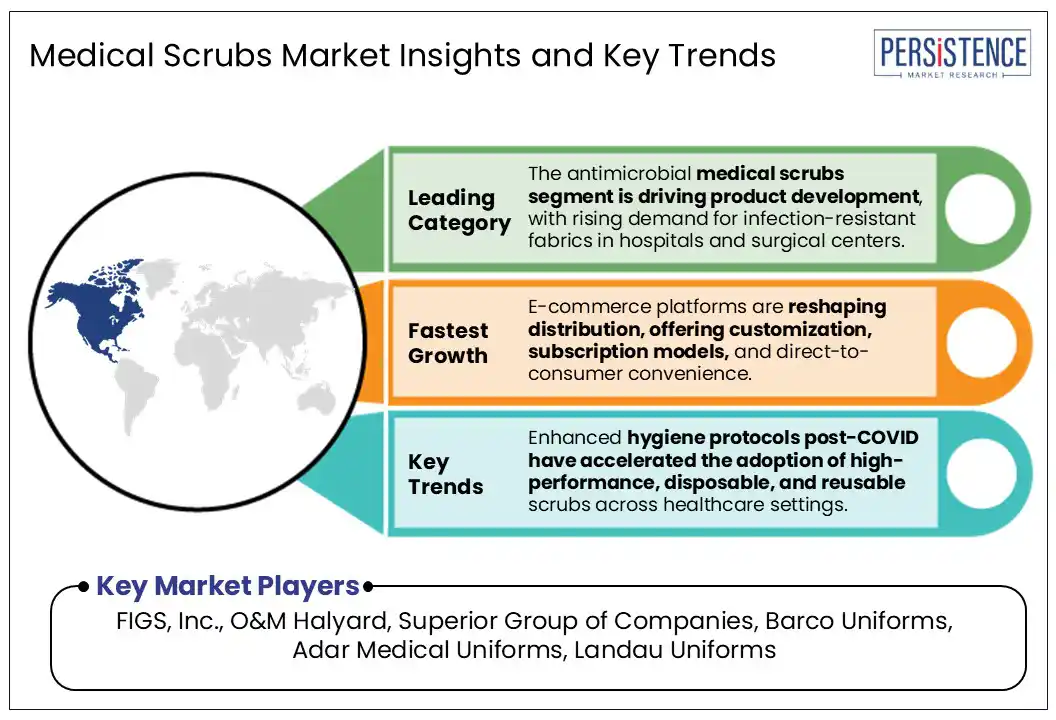ID: PMRREP35522| 189 Pages | 28 Jul 2025 | Format: PDF, Excel, PPT* | Healthcare

The global medical scrubs market size is expected to be valued at US$ 13.29 Bn in 2025 and is projected to reach US$ 24.86 Bn by 2032, growing at a CAGR of 9.4% during the forecast period 2025 - 2032.
The global medical scrubs market growth is driven by the growing demand for hygienic and functional healthcare apparel across hospitals, clinics, and surgical centers. With infection control as a leading priority, the use of antimicrobial medical uniforms and sustainable healthcare clothing is gaining momentum around the world.
The market is growing due to innovations in fabric technology, increasing healthcare employment, and infrastructural development. The trend of fashionable, comfortable, and environmentally friendly scrubs is changing consumer tastes, particularly in developed areas.

Key Industry Highlights
|
Market Attribute |
Key Insights |
|
Medical Scrubs Market Size (2025E) |
US$ 13.29 Bn |
|
Market Value Forecast (2032F) |
US$ 24.86 Bn |
|
Projected Growth (CAGR 2025 to 2032) |
9.4% |
|
Historical Market Growth (CAGR 2019 to 2024) |
8.6% |
The rising demand for antimicrobial medical scrubs for infection control is a significant driver of market growth, particularly in hospitals and surgical centers where hygiene standards are of increasing importance. These scrubs offer enhanced protection against pathogens, making them essential in high-risk environments. The surge in global healthcare employment and expansion of clinical facilities is fueling the need for customized healthcare uniforms for hospital staff, tailored to meet both functional and branding requirements.
The surge in global healthcare employment and expansion of clinical facilities is fueling the need for customized healthcare uniforms for hospital staff, tailored to meet both functional and branding requirements. Healthcare facilities in countries such as the U.S. and the U.K. have mandated uniform color codes for different departments (e.g., green for surgeons, blue for nurses).
Growing awareness around sustainability is also reshaping consumer preferences, with institutions increasingly opting for eco-friendly medical apparel for healthcare professionals. This shift is encouraging manufacturers to invest in recyclable fabrics and low-impact production methods. Moreover, the rise of digital retail and subscription models is making premium medical scrubs for nurses and doctors more accessible, driving demand in urban and semi-urban markets.
Manufacturers face challenges in meeting the rising demand for custom-fit antimicrobial scrubs for hospital staff, especially in regions with limited access to advanced textile technologies. High production costs and strict regulatory standards for medical-grade fabrics often delay product launches and limit innovation. The lack of awareness about infection-resistant medical clothing for outpatient clinics in developing economies restricts market expansion.
The market also struggles with supply chain disruptions and fluctuating raw material prices, which impact the availability of sustainable medical uniforms for healthcare professionals. Smaller brands find it difficult to compete with established players offering premium healthcare apparel with antimicrobial properties, leading to limited diversity in product offerings. These restraints collectively slow down the adoption of advanced scrubs in cost-sensitive markets.
Manufacturers can capitalize on the rising demand for custom-designed antimicrobial scrubs for surgical teams, especially in high-volume hospitals and specialty clinics. By integrating advanced textile technologies and ergonomic designs, brands can offer tailored solutions that enhance both safety and comfort. The growing preference for breathable medical uniforms for long shifts presents lucrative opportunities to innovate with moisture-wicking and temperature-regulating fabrics.
The shift toward sustainability opens doors for companies to develop biodegradable healthcare clothing for clinical staff, aligning with global eco-conscious initiatives. For instance, Barco Uniforms launched the Barco Unify line made from recycled plastic bottles, emphasizing eco-friendly scrubs without compromising performance. The expansion of online retail platforms allows brands to reach new markets with digitally personalized medical scrubs for nurses and doctors, offering customization and subscription-based models. These trends collectively create a fertile ground for growth in both developed and emerging economies.
By product type, antimicrobial scrubs lead the market due to their critical role in infection control, especially in surgical and ICU settings. Antimicrobial scrubs account for approximately 48% of the global market share. These scrubs are designed with advanced fabric technologies that resist microbial growth, making them essential in high-risk medical environments. These scrubs incorporate antimicrobial agents such as silver or copper ions to inhibit microbial colonization, reducing surface bacteria by over 99% within minutes of contact. The post-COVID emphasis on PPE hygiene has reinforced their relevance in both public and private healthcare systems.
Disposable scrubs are the fastest-growing, as they are preferred in emergency care and isolation wards, particularly post-COVID. Their convenience, hygiene benefits, and increasing use in high-risk environments make them a preferred choice for many healthcare institutions. Disposable scrubs eliminate the need for laundering and reduce cross-contamination risks, making them ideal for short-term procedures, visiting medical staff, and emergency deployments. Post-2020, their demand has accelerated across intensive care units (ICUs), COVID wards, and field hospitals, especially in regions where healthcare infrastructure is rapidly evolving.
Offline retail is the leading segment, accounting for approximately 52% of the market share. This segment includes traditional medical supply stores, hospital-affiliated retail outlets, and institutional contracts that cater to large-scale bulk orders for hospitals, clinics, and government health departments. These channels benefit from long-established relationships, negotiated pricing agreements, and the assurance of consistent quality and timely delivery, factors that are particularly crucial in resource-limited settings.
Online platforms are rapidly gaining traction, especially in urban and semi-urban areas. The growth is driven by increasing internet expansion and digital payment adoption. E-commerce platforms provide healthcare professionals with greater convenience and broader product selections. Many platforms now offer customization options such as monogramming, color selection, and fabric preferences, which are becoming particularly popular among younger professionals. For example, Figs, a U.S.-based company, has built a direct-to-consumer (DTC) e-commerce platform, offering personalized embroidery, size-guided fitting, and bundle subscription services for nurses and doctors.

North America leads the global medical scrubs market, holding approximately 41% of the total market share. This dominance is driven by a well-established healthcare infrastructure, strict hygiene protocols, and strong institutional procurement. The U.S. commands the largest share within the region due to its extensive network of healthcare facilities, including over 6,000 hospitals and numerous outpatient centers, nursing homes, and surgical clinics. The country is also home to major industry players such as FIGS, Cherokee Uniforms, Barco Uniforms, and Healing Hands, who continuously innovate with antimicrobial, ergonomic, and fashion-forward designs to meet the evolving preferences of healthcare professionals. The implementation of OSHA and CDC guidelines also reinforces the demand for high-quality medical scrubs.
In Canada, the expansion of telehealth and home care services has increased the need for versatile, multipurpose scrubs that offer both comfort and compliance with clinical standards in non-traditional care settings. The region’s demand is further fueled by government contracts and bulk purchases by healthcare systems, making it the most mature and commercially active market globally.
Asia Pacific is the fastest-growing region, driven by rapid healthcare infrastructure development and a rising medical workforce. Countries such as India, China, and Indonesia are investing heavily in hospital construction, infection control, and public health programs. India is emerging as a major manufacturing and export hub for medical apparel. Backed by government programs such as the Production Linked Incentive (PLI) scheme, ‘Make in India’, and the Andhra Pradesh MedTech Zone (AMTZ), the country is producing cost-effective scrubs at scale. The domestic market is growing due to the expansion of public hospitals, private hospital chains, and increasing rural health coverage. Innovations in antimicrobial and fluid-repellent textiles are being led by startups and textile-tech partnerships.
China continues to lead the region in mass production capacity, supplying scrubs to global markets through large textile manufacturers. In response to the COVID-19 pandemic, the country ramped up investments in PPE-integrated scrubs and continues to focus on domestic procurement, especially in Tier 2 and Tier 3 cities where hospital infrastructure is rapidly modernizing. China’s strategic initiatives under the Healthy China 2030 plan are spurring healthcare workforce expansion and demand for uniforms in allied health professions.
Europe holds a substantial share of the market, estimated at around 23%. The region places strong emphasis on hygiene, sustainability, and compliance with EU health standards. Countries such as Germany, France, and the U.K. are leading adopters of eco-friendly medical uniforms, incorporating advanced fabric technologies such as moisture-wicking and antimicrobial finishes. Germany is investing in special protective clothing for high-risk departments, including emergency care and infectious disease units, and France’s public health initiatives are fueling demand for eco-friendly and reusable medical uniforms, especially in regional hospitals and outpatient clinics.
The U.K., post-Brexit, has seen a rise in domestic procurement and innovation in healthcare apparel. Institutional contracts and healthcare reforms across the EU continue to support market expansion, especially in the premium and sustainable segments. Nordic countries such as Sweden and Denmark are adopting carbon-neutral medical clothing policies, while Southern Europe, especially Spain and Italy, are revitalizing domestic textile industries to meet hospital needs with eco-friendly and antimicrobial options. EU funding for healthcare system modernization is also indirectly boosting the demand for upgraded medical uniforms.
The global medical scrubs market is highly competitive, with a mix of established players and emerging brands shaping its growth trajectory. Leading companies include FIGS, Inc. O&M Halyard, Superior Group of Companies, Inc. Barco Uniforms, and Adar Medical Uniforms, LLC.
Innovation remains a key strategy across the board. Companies are investing in advanced fabric technologies such as moisture-wicking, stretchable, and antimicrobial materials to enhance comfort and performance. The demand for customized medical uniforms is also rising, prompting brands to offer tailored fits, color options, and branding features. Sustainability is another major focus with brands such as FIGS and Barco Uniforms introducing eco-friendly medical apparel and recyclable packaging to meet growing environmental concerns.
The global medical scrubs market is projected to reach US$ 13.29 Bn in sales by 2025.
The medical scrubs market is expected to grow to US$ 24.86 Bn, by 2032.
Key trends include the adoption of antimicrobial and infection-resistant fabrics, rising demand for eco-friendly medical apparel, and the growth of customized and ergonomic scrubs.
The antimicrobial scrubs segment leads the market due to its critical role in infection control, especially in surgical and ICU settings.
The medical scrubs market is projected to grow at a CAGR of 9.4% from 2025 to 2032, driven by increased healthcare infrastructure and demand for hygienic, functional apparel.
Leading players with strong portfolios include FIGS, Inc., O&M Halyard, Superior Group of Companies, Barco Uniforms, and Adar Medical Uniforms.
|
Report Attribute |
Details |
|
Historical Data/Actuals |
2019 - 2024 |
|
Forecast Period |
2025 - 2032 |
|
Market Analysis |
Value: US$ Bn |
|
Geographical Coverage |
|
|
Segmental Coverage |
|
|
Competitive Analysis |
|
|
Report Highlights |
|
|
Customization and Pricing |
Available upon request |
By Product Type
By Distribution Channel
By End-user
By Region
Delivery Timelines
For more information on this report and its delivery timelines please get in touch with our sales team.
About Author